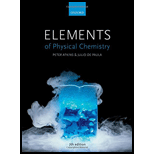
Concept explainers
(a)
Interpretation:
Standard molar enthalpy of combustion has to be calculated.
(a)
Explanation of Solution
The heat released in a bomb calorimeter is equivalent to the charge in internal energy because the combustion occurs at constant volume.
Assuming the volume of condensed phases is negligible in comparison to that of gases behave perfectly, then
For a combustion reaction of glucose,
Here,
Standard molar enthalpy of combustion is
(b)
Interpretation:
Standard internal energy of combustion has to be calculated.
(b)
Explanation of Solution
The heat released in a bomb calorimeter is equivalent to the charge in internal energy because the combustion occurs at constant volume.
Assuming the volume of condensed phases is negligible in comparison to that of gases behave perfectly, then
For a combustion reaction of glucose,
Here,
Standard internal energy of combustion is
(c)
Interpretation:
Standard enthalpy for the formation of glucose has to be calculated.
(c)
Explanation of Solution
For the formation of glucose,
As the sum of the formation reaction for
For which the enthalpy changes are known, minus the combustion reaction
Thus,
Want to see more full solutions like this?
Chapter 2 Solutions
Elements Of Physical Chemistry
 ChemistryChemistryISBN:9781305957404Author:Steven S. Zumdahl, Susan A. Zumdahl, Donald J. DeCostePublisher:Cengage Learning
ChemistryChemistryISBN:9781305957404Author:Steven S. Zumdahl, Susan A. Zumdahl, Donald J. DeCostePublisher:Cengage Learning ChemistryChemistryISBN:9781259911156Author:Raymond Chang Dr., Jason Overby ProfessorPublisher:McGraw-Hill Education
ChemistryChemistryISBN:9781259911156Author:Raymond Chang Dr., Jason Overby ProfessorPublisher:McGraw-Hill Education Principles of Instrumental AnalysisChemistryISBN:9781305577213Author:Douglas A. Skoog, F. James Holler, Stanley R. CrouchPublisher:Cengage Learning
Principles of Instrumental AnalysisChemistryISBN:9781305577213Author:Douglas A. Skoog, F. James Holler, Stanley R. CrouchPublisher:Cengage Learning Organic ChemistryChemistryISBN:9780078021558Author:Janice Gorzynski Smith Dr.Publisher:McGraw-Hill Education
Organic ChemistryChemistryISBN:9780078021558Author:Janice Gorzynski Smith Dr.Publisher:McGraw-Hill Education Chemistry: Principles and ReactionsChemistryISBN:9781305079373Author:William L. Masterton, Cecile N. HurleyPublisher:Cengage Learning
Chemistry: Principles and ReactionsChemistryISBN:9781305079373Author:William L. Masterton, Cecile N. HurleyPublisher:Cengage Learning Elementary Principles of Chemical Processes, Bind...ChemistryISBN:9781118431221Author:Richard M. Felder, Ronald W. Rousseau, Lisa G. BullardPublisher:WILEY
Elementary Principles of Chemical Processes, Bind...ChemistryISBN:9781118431221Author:Richard M. Felder, Ronald W. Rousseau, Lisa G. BullardPublisher:WILEY





